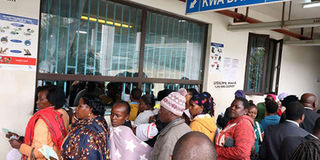Pharmacies can reduce cost of basic healthcare

Patients purchase medicines at Mama Lucy Kibaki Hospital in Nairobi on September 9, 2019. By using market data, the formal pharmacy sector can become the bellwether for efficient and effective basic primary healthcare for all. PHOTO | FILE | NATION MEDIA GROUP
What you need to know:
- Kenya’s pharmaceutical market is one of the fastest-growing sectors in sub-Sahara, with over 15,000 thousand private pharmacies.
- The Pharmacy and Poisons Board should ensure that proper channels are put in place to streamline registering and monitoring of pharmacists in Kenya.
Food, education and healthcare are a priority for most low-middle income households grappling with the increasing costs of daily life.
Although basic nutrition needs are paramount, the quest to expand access to quality and affordable healthcare as a key plank in eliminating extreme poverty and promoting shared prosperity is quickly gaining momentum.
Healthcare is a growth industry as much as it is a fundamental service to humanity. In Kenya, the implementation of Universal Healthcare (UHC) as a national health priority is of paramount importance and is gaining traction.
Achieving universal health coverage is currently being piloted in just four counties.
As such, delivery of mass access remains via primary healthcare. The fundamental premise of primary healthcare, according to the World Health Organisation (WHO), is to provide all people, everywhere, with the right care in their community.
This premise makes it people-centred rather than disease-focused and predicates a full life cycle that includes health promotion, disease prevention, treatment, rehabilitation and palliative care.
VITAL ROLE
Low to middle-income Kenyans mostly organise themselves in communal settings and take a neighbourhood approach to solving daily issues. This means millions of people rely on health service points which are in proximity to their homes.
For those living in urban centres, they utilise pharmacies that are the closest to their houses. For them, this means improved access, convenience, efficiency, desired quality — all at a lower cost.
This function is extremely critical for emerging consumers, who can be vulnerable to falling back into poverty due to an illness.
Kenya’s pharmaceutical market is one of the fastest-growing sectors in sub-Sahara, with over 15,000 thousand private pharmacies.
Statistics also show that close to 66 per cent are unlicensed or unregulated. This explosive growth is in response to the health demands of a growing population and the high incidence of chronic diseases.
REGULATION
Non-communicable diseases such as hypertension, diabetes, cancer and other chronic illnesses contribute to a growing trend of deaths in Kenya, with industry estimates attributing about 27 per cent of deaths.
The popularity of over-the-counter medication and the fact that medicine accounts for nearly 40 per cent of the total cost of healthcare means pharmacies have a fundamental role to play in ramping up accessibility as well as reducing the cost burden of basic primary healthcare services.
As we think of solutions to the issues facing the healthcare sector, one of the quickest solutions is to continue to work with the Pharmacy and Poisons Board (PPB), who are the regulators of the industry.
Through their processes, they will ensure that proper channels are put in place to streamline registering and monitoring of pharmacists in Kenya. This will assist to eradicate quack entrepreneurs.
BOGUS DRUGS
Although the PPB has done a remarkable job under difficult circumstances in purging unlicensed pharmacies, there are still an estimated 20-25 per cent of drugs sold in the country that are counterfeit.
Because they contain few or no key active ingredients, counterfeit medicine can cause adverse reactions and even death.
Generally, high quality medicines remain expensive in Kenya because of the highly-fragmented pharmaceutical distribution systems.
Given the lack of coordinated distribution, intermediaries mark up prices to the extent that even the lowest-priced generic medicines in Kenya are two-five times higher than their international reference points.
The second element is to overlay the services at the formal pharmacies with the National Hospital Insurance Fund (NHIF), which has over six million members, when it rolls out coverage to include private outpatient pharmacies.
This partnership will force the pharmacies to build healthcare services into their business models that ensure partnerships with healthcare providers with relevant services and expertise.
PARTNERSHIPS
An example is integrating reputable lab services into pharmacies to address the emerging problem of unlicensed labs within pharmacies that lead to misdiagnosis.
These partnerships will also encourage physicians to talk to patients about the importance of overall well-being and quality medicine.
Thirdly, by tapping into the benefits of technology, the pharmacies would be compelled to venture into e-health technology — a growing area globally even if cultural challenges will have to be overcome in Kenya. This would benefit consumers.
By using market data such as patient demographics, spending trends, disease patterns and chronic health history, the formal pharmacy sector can spread its footprints across the country and into community neighbourhoods and become the bellwether for efficient and effective basic primary healthcare for all.
Mr Khalfan is the CEO of Goodlife Pharmacy, a branded chain operating in Kenya and Uganda. [email protected]




